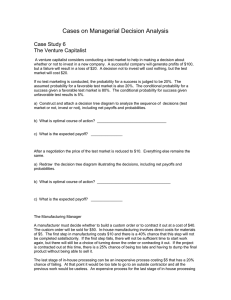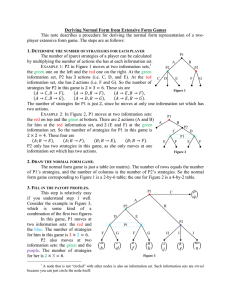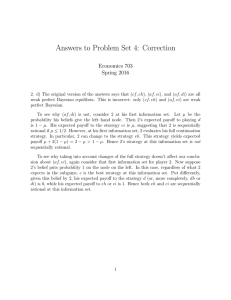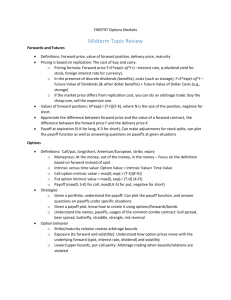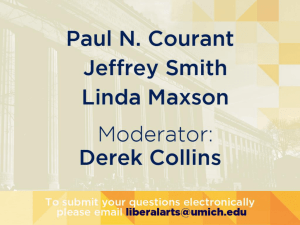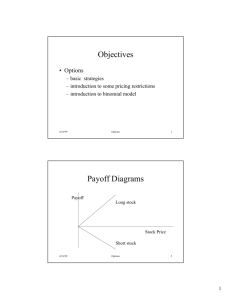A Game for Ad Hoc Network Connectivity in the
advertisement
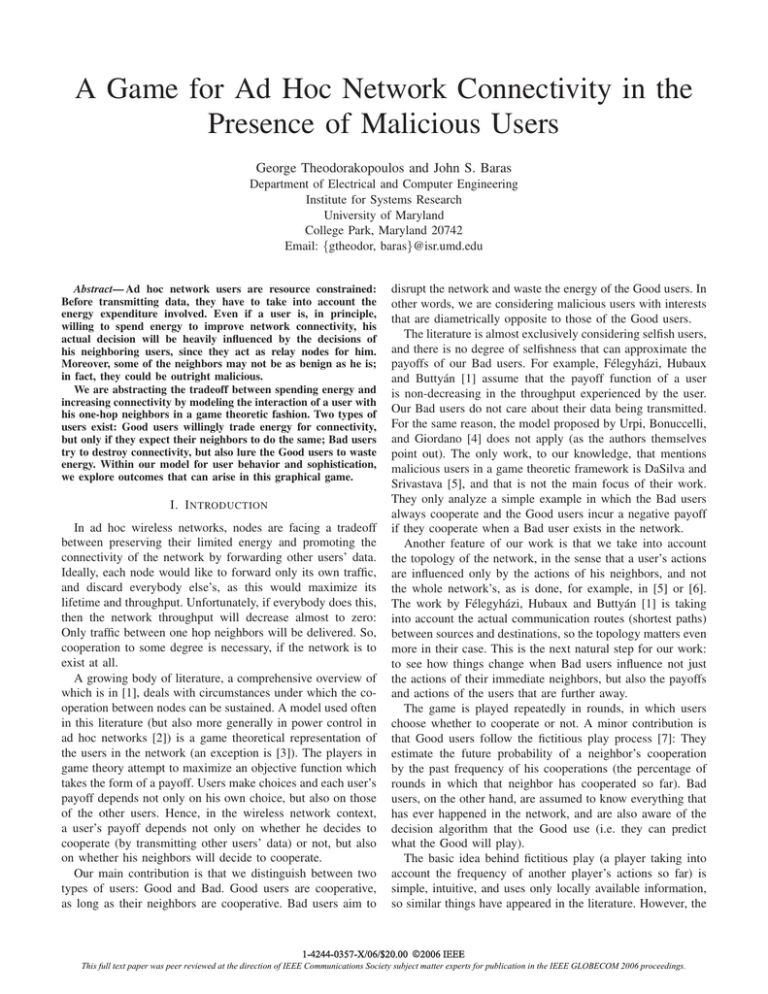
A Game for Ad Hoc Network Connectivity in the
Presence of Malicious Users
George Theodorakopoulos and John S. Baras
Department of Electrical and Computer Engineering
Institute for Systems Research
University of Maryland
College Park, Maryland 20742
Email: {gtheodor, baras}@isr.umd.edu
Abstract— Ad hoc network users are resource constrained:
Before transmitting data, they have to take into account the
energy expenditure involved. Even if a user is, in principle,
willing to spend energy to improve network connectivity, his
actual decision will be heavily influenced by the decisions of
his neighboring users, since they act as relay nodes for him.
Moreover, some of the neighbors may not be as benign as he is;
in fact, they could be outright malicious.
We are abstracting the tradeoff between spending energy and
increasing connectivity by modeling the interaction of a user with
his one-hop neighbors in a game theoretic fashion. Two types of
users exist: Good users willingly trade energy for connectivity,
but only if they expect their neighbors to do the same; Bad users
try to destroy connectivity, but also lure the Good users to waste
energy. Within our model for user behavior and sophistication,
we explore outcomes that can arise in this graphical game.
I. I NTRODUCTION
In ad hoc wireless networks, nodes are facing a tradeoff
between preserving their limited energy and promoting the
connectivity of the network by forwarding other users’ data.
Ideally, each node would like to forward only its own traffic,
and discard everybody else’s, as this would maximize its
lifetime and throughput. Unfortunately, if everybody does this,
then the network throughput will decrease almost to zero:
Only traffic between one hop neighbors will be delivered. So,
cooperation to some degree is necessary, if the network is to
exist at all.
A growing body of literature, a comprehensive overview of
which is in [1], deals with circumstances under which the cooperation between nodes can be sustained. A model used often
in this literature (but also more generally in power control in
ad hoc networks [2]) is a game theoretical representation of
the users in the network (an exception is [3]). The players in
game theory attempt to maximize an objective function which
takes the form of a payoff. Users make choices and each user’s
payoff depends not only on his own choice, but also on those
of the other users. Hence, in the wireless network context,
a user’s payoff depends not only on whether he decides to
cooperate (by transmitting other users’ data) or not, but also
on whether his neighbors will decide to cooperate.
Our main contribution is that we distinguish between two
types of users: Good and Bad. Good users are cooperative,
as long as their neighbors are cooperative. Bad users aim to
disrupt the network and waste the energy of the Good users. In
other words, we are considering malicious users with interests
that are diametrically opposite to those of the Good users.
The literature is almost exclusively considering selfish users,
and there is no degree of selfishness that can approximate the
payoffs of our Bad users. For example, Félegyházi, Hubaux
and Buttyán [1] assume that the payoff function of a user
is non-decreasing in the throughput experienced by the user.
Our Bad users do not care about their data being transmitted.
For the same reason, the model proposed by Urpi, Bonuccelli,
and Giordano [4] does not apply (as the authors themselves
point out). The only work, to our knowledge, that mentions
malicious users in a game theoretic framework is DaSilva and
Srivastava [5], and that is not the main focus of their work.
They only analyze a simple example in which the Bad users
always cooperate and the Good users incur a negative payoff
if they cooperate when a Bad user exists in the network.
Another feature of our work is that we take into account
the topology of the network, in the sense that a user’s actions
are influenced only by the actions of his neighbors, and not
the whole network’s, as is done, for example, in [5] or [6].
The work by Félegyházi, Hubaux and Buttyán [1] is taking
into account the actual communication routes (shortest paths)
between sources and destinations, so the topology matters even
more in their case. This is the next natural step for our work:
to see how things change when Bad users influence not just
the actions of their immediate neighbors, but also the payoffs
and actions of the users that are further away.
The game is played repeatedly in rounds, in which users
choose whether to cooperate or not. A minor contribution is
that Good users follow the fictitious play process [7]: They
estimate the future probability of a neighbor’s cooperation
by the past frequency of his cooperations (the percentage of
rounds in which that neighbor has cooperated so far). Bad
users, on the other hand, are assumed to know everything that
has ever happened in the network, and are also aware of the
decision algorithm that the Good use (i.e. they can predict
what the Good will play).
The basic idea behind fictitious play (a player taking into
account the frequency of another player’s actions so far) is
simple, intuitive, and uses only locally available information,
so similar things have appeared in the literature. However, the
1-4244-0357-X/06/$20.00 ©2006 IEEE
This full text paper was peer reviewed at the direction of IEEE Communications Society subject matter experts for publication in the IEEE GLOBECOM 2006 proceedings.
main ingredient of fictitious play is that this frequency is used
to predict the future behavior of the other player, an ingredient
that does not exist in the related work.
Ref. [1] uses strategies that depend only on what happened
in the previous time instant (time slot, according to their terminology). Ref. [6] is using a modified version of Generous Tit
For Tat, but they have no notion of topology and, consequently,
of neighborhoods. In their setting, each user is comparing
his own frequency of cooperation to the aggregate frequency
of cooperation of the rest of the network. Altman, Kherani,
Michiardi, and Molva [8] proposed a scheme for punishing
users whose frequency of cooperation is below the one dictated
by a certain Nash equilibrium.
The importance of making the explicit connection to the
concept of fictitious play is that many results could be transferred from that area. For example, if all the players have the
same utility function, then the fictitious play process always
converges to a Nash equilibrium [9].
This paper is organized as follows: We describe our system
model in section II. In section III we describe the fictitious
play strategy that the Good follow; we analyze and compare
two fundamental strategies for the Bad; we find the optimal
solution in two example graphs. Section IV concludes.
II. S YSTEM MODEL
We consider a wireless network of Good and Bad users,
modeled as an undirected graph G = (V, E), where VG is the
set of Good users, VB is the set of Bad users, VG ∩ VB = ∅,
and V = VG ∪ VB . An edge (i, j) means that i and j are
within communication range, but not necessarily that the link
is being used for transmission. Each user has a choice between
cooperating (C) to activate the adjacent links, or defecting
(D), which effectively kills all adjacent links. A link (i, j) is
considered to be active if and only if both users i and j choose
to cooperate (C). Each user chooses only one action (C or D)
for all links, not one action per link.
We now describe what Good and Bad users want to
achieve, and how that translates to game theoretic payoffs.
The objective of each Good user is to activate the wireless
links to as many of his neighbors as possible. So, for each
adjacent link that is active, a Good user receives a payoff of
N . However, choosing C costs energy, regardless of what the
neighbors choose. So, a C incurs a negative payoff of −E
per adjacent link. It holds that N ≥ E ≥ 0, otherwise the
Good would not have an incentive to play C, so everyone
would always play D. In the real operation of the network,
a C would correspond to sending/forwarding and receiving
traffic; a D would effectively correspond to shutting down
communication: neither send, nor receive.
The objective of each Bad user is the exact opposite of the
Good users’. They want to disrupt connectivity by keeping
links inactive, and they also want the Good users to waste
their energy. So, the Bad users incur a negative payoff of −N
per active adjacent link, but gain E for each Good neighbor
of theirs that plays C. Moreover, they do not spend energy
when cooperating. We assume that there are no links between
C
Good
D
Bad
C
N − E, E − N
0, 0
D
−E, E
0, 0
C
Good
D
Good
C
N − E, N − E
0, −E
D
−E, 0
0, 0
Fig. 1. The games on the links for Good versus Bad and Good versus Good
neighbors.
Bad users, so they never gain anything in terms of increased
connectivity by activating links.
All these considerations are incorporated in the two payoff
matrices of Fig. 1. Note that there is no Bad vs. Bad game,
since no Bad users are neighbors. Also note that the payoffs
for a Good user depend only on the actions of himself and the
other player, but not on the type of the other player. This comes
from a modeling decision, namely that the Good users do
not mind cooperating with Bad users: We look at cooperation
only from the point of view of connectivity (traffic forwarding
under energy constraints), which means that the Bad users do
not have any incentive to cooperate in order to, e.g., get access
to Good user communications.
The game is a repeated game with simultaneous moves. It
is played in rounds, at every round each player chooses an
action independently of all the others, and the action of each
user is announced to all his neighbors. Then, the payoffs along
each link are computed and each user receives the sum of the
payoffs along his adjacent links. After that, the users decide
on their action for the next round. The notation for the payoffs
of user i will be: Ri (ai aj |x), where ai is i’s action, aj is j’s
(the neighbor’s) action, ai , aj ∈ {C, D}, and x is i’s type
(x ∈ {Good, Bad}). If aj is omitted, we will be referring to
the payoff of user i when he plays action ai . To illustrate, the
total payoff of user i for a single round is (Ni is the set of i’s
neighbors)
Ri (ai |x) =
Ri (ai aj |x).
(1)
j∈Ni
We are assuming that the Good users are constrained to play
according to fictitious play, which means that a Good user’s
neighbor who has so far played c times C and d times D is
c
assumed to play C with probability c+d
. So, at each round
each Good user is choosing the action that maximizes his
expected payoff given the probability estimates for the actions
of the neighbors. The motivation for considering fictitious play
behavior is that we do not want to overburden the users with
excessive computation requirements. Moreover, if all players
are Good, the fictitious play process converges to a Nash
equilibrium [9].
The Bad users, however, are not constrained to play according to fictitious play. They can play according to any strategy
they want, and they also know everything that is happening in
the network (the actions taken by any player at any previous
1-4244-0357-X/06/$20.00 ©2006 IEEE
This full text paper was peer reviewed at the direction of IEEE Communications Society subject matter experts for publication in the IEEE GLOBECOM 2006 proceedings.
point in time). They also know the types of everyone else, and
they can coordinate their actions with the other Bad users.
The payoff for the repeated game is the average of the per
round payoffs. That is, if vit is the payoff for user i at round
T t =
0, 1, . . ., his payoff for the whole game is limT →∞ T1 t=1 vit .
The main thing we want to find is the maximum total payoff
that the Bad can achieve, and the corresponding Good payoff.
Remember that the Good maximize their payoff within the
constraints of fictitious play, whereas the Bad can do anything
they want. The payoff function being the long term average,
we only care about the steady state behavior.
III. A NALYSIS
We first look at what the Good players will be doing. The
Good want to maximize their expected payoff according to
fictitious play. The expected payoffs for each of the possible
actions of a Good player are (Ni is the set of i’s neighbors,
atj ∈ {C, D} is the action of player j at time t):
Ri (C|G) =
{Pr(atj = C)Ri (CC|G)
j∈Ni
+ (1 − Pr(atj = C))Ri (CD|G)}
Pr(atj = C)N − E
=
j∈Ni
=N·
(2)
Pr(atj = C) − |Ni | · E
j∈Ni
Ri (D|G) = 0.
So, if σi (ai |x) is the probability that player i will play
action ai , given that he is of type x (Good or Bad), and 1{P }
is the indicator function for the predicate P (1{P } = 1 iff P
is true), the following holds:
σi (C|G) = 1 {Ri (C|G) > Ri (D|G)}
=1 N·
Pr(atj = C) − |Ni | · E > 0
j∈Ni
(3)
|Ni | · E
=1
Pr(atj = C) >
N
j∈Ni
But the Good player i does not know the value Pr(atj =
C), j ∈ Ni , so he will estimate it according to the rules of
fictitious play. We denote by qjt the estimated probability that
player j will play C in round t + 1. For t = 0, qj0 = p (prior
estimate for all j). For t ≥ 1, qjt is the fraction of Cs in a1...t
j
weighting the prior with M rounds:
t
M p + n=1 1 anj = C
t
qj =
,
(4)
M +t
and the vector of frequencies of the Good (Bad) players at
t
t
time t is denoted by qG
(qB
). So, a Good player’s action ati
t
is determined as follows (αi = 1 for C, 0 for D):
|Ni | · E
ati = 1
qjt−1 >
,
(5)
N
j∈Ni
and the vector of actions of the Good (Bad) players at time t
is denoted by atG (atB ).
We now turn to what the Bad players will be doing. In
general, a strategy for the Bad is a choice of qB . This
encompasses all possible strategies of the Bad, since the Good
follow fictitious play, and therefore only respond to different
frequencies: nothing more elaborate will be detected by the
Good. The outcome of a particular strategy (i.e., the actions
that the Good will choose and the sum of the payoffs of all
the Bad users) can be found by setting all the Good to playing
C, and iteratively looking for Good whose payoff is negative,
setting their action to D, and continuing until there are no
changes.
Looking at the payoffs in Fig. 1, we see that in a Good
versus Bad game, playing D is a weakly dominating action
for the Bad: Regardless of what the Good plays, the Bad never
has a reason to prefer C over D. So, a strategy that would
make sense for the Bad would be “Always D”. However, this
may cause the Good to play D themselves in order to save
energy, in which case the Bad users’ payoff will drop to zero.
So, it seems it might pay off for the Bad to play C once in a
while so as to keep the Good playing C. We first analyze the
“Always D” strategy and then the “Keep the Good at C”.
A. Strategy #1: Always D
According to this strategy the Bad always play D, that is,
for all t, atB = 0. In this case, we can prove the following
theorem:
Theorem 1: If a Good player ever plays D, then he never
plays C again.
E
t
= j∈Ni qjt , and γi = N
|Ni |. Then, (5)
Proof: Let qN
i
t
t
t
becomes ai = 1{qNi > γi }. We will show that, for all i, qN
i
is non-increasing in t, so if it ever goes below γi (i.e. user i
plays D), then it will stay below γi .
t
the number of neighbors
of user i that
We denote by CN
i
t
t
=
1{a
choose action C at time t, i.e. CN
j = C}. For
j∈Ni
i
simplicity, we take the weight of the prior to be M = 1.
t
evolves:
Here is how the quantity qN
i
t
0
1
2
..
.
n
n+1
t
qN
i
pNi
1
1
2 (pNi + CNi )
1
1
2
3 (pNi + CNi + CNi )
..
.
1
n+1 (pNi
1
n+2 (pNi
1
2
n
+ CN
+ CN
+ · · · + CN
)
i
i
i
n+1
1
2
n
+ CNi + CNi + · · · + CNi + CN
)
i
Assume that the first Good player i who plays D, does so at
n
round n. This means that qN
< γi , and that his neighbors who
i
played D are Bad. Since the Bad players will keep playing D,
n+1
n+1
n
n
≤ CN
, which implies that qN
≤ qN
< γi .
we have CN
i
i
i
i
So Player i will keep playing D forever, and as far as his
behavior is concerned, it is as if he is Bad, too. We can then
repeat the argument for the remaining Good nodes.
Eventually, this process will converge to an equilibrium,
since the number of “Good nodes who still play C” is nonincreasing (by Theorem 1) and bounded below by zero.
1-4244-0357-X/06/$20.00 ©2006 IEEE
This full text paper was peer reviewed at the direction of IEEE Communications Society subject matter experts for publication in the IEEE GLOBECOM 2006 proceedings.
This Bad user strategy is the one that causes as many Good
as possible to play D. That is, “Always D” is the proper
strategy for the Bad to destroy the connectivity as much as
possible (deactivate as many links as they can). However, our
Bad users have a double objective which also includes wasting
the energy of the Good.
B. Strategy #2: Keep the Good at C
i∈Nj
(6)
because we are assuming that a Bad player only has Good
neighbors. So, the quantity to be maximized is
(E − N qj )Nj .
(7)
Fig. 2. Example Graph 1. The “Keep the Good at C” strategy is optimal.
The Bad users are shaded.
1.5
Keep Good at C
Always D
1
Bad User Payoff
We now look at what happens when the Bad want to cause
as many Good as possible to play C, so as to benefit as much
as possible from wasting their energy. This strategy is at the
other extreme of the previous one, and we will see that it does
not always bring the highest payoff to the Bad either.
Given that the Good will always play C (i.e. qG = 1, which
we will see how to guarantee), we want to find the vector qB
of frequencies for the Bad players (frequencies of playing C)
that maximizes the sum of payoffs of the Bad. The payoff of
a Bad player j is (on the average, when his frequency of Cs
is qj ):
{qj (E − N ) + (1 − qj )E} = (E − N qj )Nj
Rj (qj ) =
0.5
0
0
j∈VB
Since
arg max
q
B
(E − N qj )Nj = arg min
q
B
j∈VB
we can solve, equivalently,
min
q
B
q j Nj ,
(8)
0.4
0.6
Energy Cost (E)
0.8
1
Fig. 3. Comparison of “Keep the Good at C” with “Always D”, for the
graph of Figure 2. Connectivity benefit N is normalized to 1.
j∈VB
q j Nj
(9)
j∈VB
subject to (condition for the Good to always play C):
|Ni | · E
, for all i ∈ VG ,
qj >
N
(10)
and also subject to (condition for each Bad to have a positive
payoff):
E
(11)
0 ≤ qB ≤ .
N
The idea is that the Bad will adjust their play so as to keep
their frequencies equal to the computed qB .
For the example graph in Fig. 2, the linear program for the
strategy “Keep the Good at C” would be as follows
s.t.
q1 + 1
q7 + 2
q10 + 1
0 ≤ q1 , q7 , q10
E
The result depends on what the actual value of N
is. Namely
(RB and RG are the total payoffs for Bad and Good nodes,
respectively),
E
N
j∈Ni
min q1 + q7 + q10
0.2
E
> 2N
E
> 3N
E
> 2N
E
≤ N
and would lead to the all the Good nodes playing C, and the
Bad nodes to playing C with the corresponding frequencies.
0 ≤ · ≤ 12
1
2
2 <·≤ 3
2
3 <·≤1
(q1 , q7 , q10 )
(0, 0, 0)
E
E
(2 N
− 1, 0, 2 N
− 1)
E
E
E
(2 N − 1, 3 N − 2, 2 N
− 1)
RB
3E
2N − E
4(N − E),
while RG would be 14(N − E) − RB in each case.
The “Always D” strategy, on the other hand, would result
in
E
N
0 ≤ · ≤ 12
2
1
2 <·≤ 3
2
3 <·≤1
(q1 , q7 , q10 )
(0, 0, 0)
(0, 0, 0)
(0, 0, 0)
RB
3E
E
0
RG
14(N − E) − RB
6(N − E) − RB
0.
So we can see (Fig. 3) that the “Keep the Good at C”
strategy does at least as good as the “Always D” strategy,
E
it actually does better. Actually,
and for some values of N
the “Keep the Good at C” strategy is the optimal one for this
E
, as we can see in Figure 3.
graph, and for any value of N
C. Finding an optimal strategy
However, the optimal strategy of the Bad is not always to
keep all the Good at C. We provide the following counterex-
1-4244-0357-X/06/$20.00 ©2006 IEEE
This full text paper was peer reviewed at the direction of IEEE Communications Society subject matter experts for publication in the IEEE GLOBECOM 2006 proceedings.
ample (Fig. 4). The idea is that in certain cases it is best for
a Bad user to keep some but not all his Good neighbors at C.
In this case, the “Keep the Good at C” strategy would lead
to the following trivial linear program
s.t.
Keep Good at C
Always D
2
Bad User Payoff
min q
2.5
E
q + 1 > 2N
E
q + 3 > 4N
E
0≤
q
≤ N,
1.5
1
the solution of which would be
E
N
1
2
0≤·≤
1
2 <·≤1
q
RB
0
4E
E
2 N − 1 4(N − E)
RG
10(N − E) − RB
10(N − E) − RB .
0.5
0
0
The “Always D” strategy, on the other hand, would lead to
E
N
0 ≤ · ≤ 12
3
1
2 <·≤ 4
3
4 <·≤1
q
0
0
0
RB
4E
3E
0
RG
10(N − E) − RB
8(N − E) − RB
0.
So, in this case there is no clear winner, since each strategy
E
. They are
outperforms the other for different values of N
E
1
equivalent when N ∈ [0, 2 ], “Always D” is better when
E
4 3
E
1 4
4
N ∈ [ 7 , 4 ] and worse when N ∈ [ 2 , 7 ] ∪ [ 7 , 1].
In general, the best strategy depends heavily on the topology
and the placement of the Bad users. However, it seems that the
two strategies outlined above play a special role, and perhaps
a combination of the two will prove to be optimal.
IV. C ONCLUSION
Ad hoc networks depend on the cooperation of their members to operate successfully. However, since it costs energy
to cooperate, users have a large incentive to be selfish. In this
paper, we consider what happens if some of the network users
are not selfish, but outright malicious. We find that some of the
Good users may be forced to stop cooperating so that they preserve their energy. Depending on the relative value of energy
cost versus network connectivity, the Bad users may actually
increase their payoffs by being cooperative once in a while,
thus wasting the energy of the Good ones. Unfortunately, we
are unable to compare our results to the relevant literature,
Fig. 4.
Example Graph 2. The mixed strategy is optimal.
0.2
0.4
0.6
Energy Cost (E)
0.8
1
Fig. 5. Comparison of “Keep the Good at C” with “Always D”, for the
graph of Figure 4. Connectivity benefit N is normalized to 1.
since the literature is not considering malicious users within
a game theoretic framework to any significant extent.
In the future, we plan to elaborate on the exact connection
between the topology and the optimal strategy that the Bad
users can play against the simple fictitious play of the Good
ones. We would like to see if fictitious play is sufficient, or a
more complicated Good strategy is needed.
R EFERENCES
[1] M. Félegyházi, J.-P. Hubaux, and L. Buttyán, “Nash Equilibria of Packet
Forwarding Strategies in Wireless Ad Hoc Networks,” IEEE Transactions
on Mobile Computing, vol. 5, no. 5, pp. 463–476, May 2006.
[2] Y. Xing and R. Chandramouli, “Distributed discrete power control for
bursty transmissions over wireless data networks,” in Proc. of ICC 2004,
Paris, France, June 2004, pp. 139–143.
[3] L. Buttyan and J.-P. Hubaux, “Stimulating Cooperation in Self-Organizing
Mobile Ad Hoc Networks,” ACM/Kluwer Mobile Networks and Applications, vol. 8, no. 5, 2003.
[4] A. Urpi, M. Bonuccelli, and S. Giordano, “Modelling Cooperation in
Mobile Ad Hoc Networks: A Formal Description of Selfishness,” in
Proc. of WiOpt 2003: Modeling and Optimization in Mobile, Ad Hoc
and Wireless Networks, INRIA Sophia-Antipolis, France, Mar. 2003.
[5] L. A. DaSilva, and V. Srivastava, “Node Participation in Ad Hoc and
Peer-to-Peer Networks: A Game-Theoretic Formulation”, in Workshop on
Games and Emergent Behaviors in Distributed Computing Environments,
Birmingham, UK, Sep. 2004.
[6] V. Srinivasan, P. Nuggehalli, C.-F. Chiasserini, and R. Rao, “Cooperation
in Wireless Ad Hoc Networks,” in Proc. of IEEE Infocom 2003, San
Francisco, March 30-April 3 2003.
[7] D. Fudenberg and D. K. Levine, The Theory of Learning in Games. MIT
Press, 1998.
[8] E. Altman, A. Kherani, P. Michiardi, and R. Molva, “Non-cooperative
Forwarding in Ad Hoc Networks,” INRIA, Tech. Rep. RR-5116, 2004.
[9] D. Monderer and L. S. Shapley, “Fictitious Play Property for Games
with Identical Interests,” Journal of Economic Theory, vol. 68, no. 1, pp.
258–265, January 1996.
0 Work prepared through collaborative participation in the Communications
and Networks Consortium sponsored by the U.S. Army Research Laboratory under the Collaborative Technology Alliance Program, Cooperative
Agreement DAAD19-01-2-0011. Research also supported by the U.S. Army
Research Office under grant No DAAD19-01-1-0494. The U.S. Government
is authorized to reproduce and distribute reprints for Government purposes
notwithstanding any copyright notation thereon. Any opinions, findings, and
conclusions or recommendations expressed in this publication are those of the
authors and do not necessarily reflect the views of the sponsors.
1-4244-0357-X/06/$20.00 ©2006 IEEE
This full text paper was peer reviewed at the direction of IEEE Communications Society subject matter experts for publication in the IEEE GLOBECOM 2006 proceedings.


